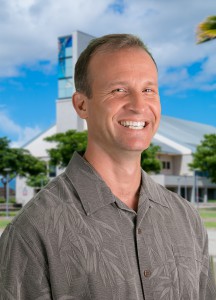
Oboist J. Scott Janusch examines the kauila wood oboe at the Howarth of London factory
An oboe concerto composed by UH West Oʻahu Associate Professor of Music Jon Magnussen will have its debut next month in a set of performances welcoming home the world’s first and only oboe made of Hawaiian kauila wood.

Associate Professor of Music Jon Magnussen
Dr. Magnussen was commissioned to compose “Nā Kau ʻElua | The Two Seasons” for oboist J. Scott Janusch and the Hawaiian Oboe Legacy Project, which involved the crafting of an oboe out of kauila wood thought to be 200- to 300-years old. Magnussen also helped in researching the historic importance of the wood, which is one of Hawaiʻi’s hardest native woods and was used for the making of everyday objects including farming tools, kapa beaters, and weapons.
The concerto is a 12-movement work for string quartet, piano, Hawaiian and western percussion instruments and a solo oboe. Magnussen paid heed to the kauila wood’s age by composing Nā Kau ʻElua | The Two Seasons using harmonies and melodies from Antonio Vivaldi’s “The Four Seasons” (1721), a concerto written roughly around the same time as when the oboe’s wood began to grow.
The 12-movement design also reflects the 12 lunar moons of the Hawaiian year, which is divided into two seasons: wet (kau hoʻoilo) and dry (kau wela). Each of the movements features a concept or object traditionally made of kauila wood:
KAU HOʻOILO (Wet season)
- Ka ʻŌʻō (The Digging Stick)
- Ka Papa Hōlua (The Hōlua Sled)
- Kā Līloa Lāʻau Pālau (Līloa’s War Club)
- He Mele No Kālāʻau (A Kālāʻau Song)
- Ka Ihe (The Spear)
- Ke Kia Manu (The Bird Catcher’s Pole)
KAU WELA (Dry season)
- Ka Puhi o Laumeki (The Eel of the ʻAnae-Holo)
- Ka ʻAuamo (The Carrying Pole)
- Ka Iʻe Kuku (The Kapa Beater)
- Ka Lāʻau Pālau (The War Club)
- Ka Hiʻa Kā ʻUpena (The Netting Needle)
- Ka Pāhoa (The Dagger)
Magnussen relayed that the wood for oboe came from a kauila tree that was damaged by a hurricane in the 1980s near the Waimea Canyon on Kauaʻi and brought by Anahola resident Ed Kaʻiwi to noted luthier Mickey Susmann, who years later gave some of it to Janusch, who had conceived the Hawaiian Oboe Legacy Project. The kauila wood then made its way to Howarth of London, an internationally known maker of oboes, where the instrument was constructed by hand over a two-year period.
In December the oboe arrived in Hawaiʻi. Janusch, in a piece written for Chamber Music Hawaiʻi’s newsletter, said he had worried the oboe might be too heavy or cumbersome; however it is lighter than other Howarth oboes he has and produces a “lovey” sound. Plans for the instrument call for Live Music Awareness, the fiscal sponsor of the Hawaiian Oboe Legacy Project, to care for the oboe and make it available for generations to come.
The premiere performance of Nā Kau ʻElua | The Two Seasons and the debut of the Hawaiian Oboe Legacy Project will be part of Chamber Music Hawaiʻi’s season finale during a pair of performances in May. Janusch, who is the principal oboist for the Hawaiʻi Symphony Orchestra, will perform with the Galliard String Quartet, UH Mānoa Professor of Music Thomas Yee, and Jordan Schifino, Hawaiʻi Symphony Orchestra percussionist. The performances are scheduled for:
- Monday, May 6: Magnussen’s composition along with the Mozart Oboe Quartet will be performed at 7:30 p.m. at the Paliku Theatre on the Windward Community College Campus.
- Monday, May 20: The program repeats. 7:30 p.m., Doris Duke Theatre at the Honolulu Museum of Art.
General admission tickets are $35, but students can attend for free with valid ID. For ticket information, see www.chambermusichawaii.org.
There also will be preview performances of Nā Kau ʻElua | The Two Seasons presented by Live Music Awareness (admission is free) in late April. The program will also include the Mozart Oboe Quartet and be performed by Janusch, the Galliard String Quartet, Yee, and Schifino. The performances are scheduled for:
- Friday, April 26, 7 p.m., Haleiwa Historic Gym (66-434 Kamehameha Highway, Haleiwa)
- Saturday, April 27, 7 p.m., Waiʻanae Baptist Church (85-131 Ala Hema St., Waiʻanae)
Another composition by Magnussen, his 2002 ballet, “Psalm,” will be performed by The State University of New York at Purchase from May 1 to 4. Magnussen said the college’s dance and music divisions are collaborating on the project and that he will travel to help with rehearsals, performances, a pre-concert artist discussion and a presentation of his music. Psalm had its premiere as part of the 2002 Salt Lake Olympic Arts Festival.
